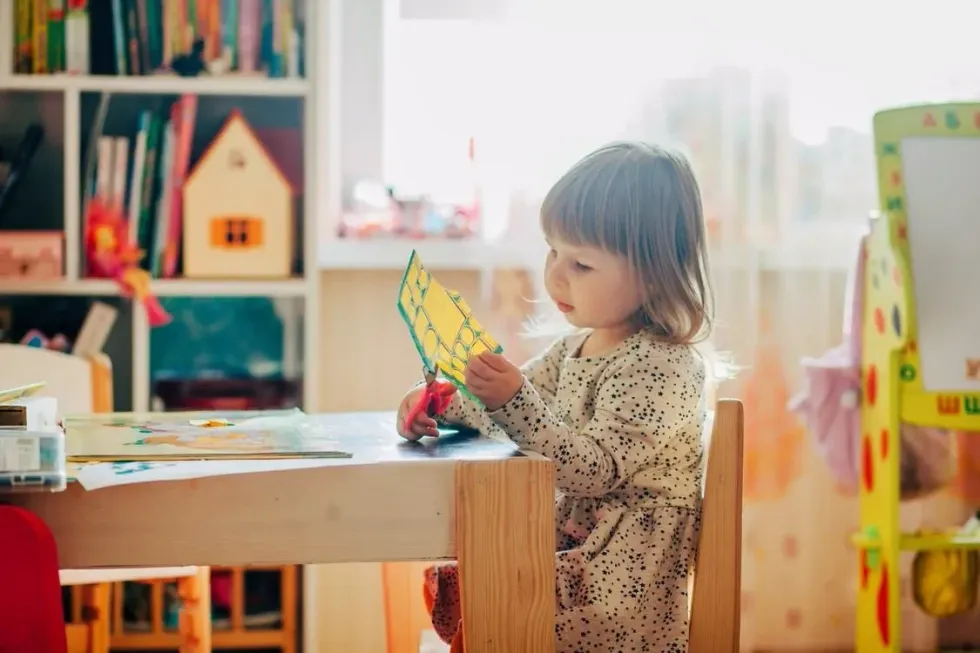Do you have a child who will turn five between September 2 and December 2?
This means that if they were to go straight from preschool to regular kindergarten, they will be one of the youngest in their class, so you might be curious about your other options.
Some parents in this position decide to go ahead and enroll their children in regular school, others opt for an extra year of preschool, and then there is transitional kindergarten, an extra school year, funded by local school districts just like regular school programs.
Transitional kindergarten programs work to bridge the gap between the freedom of preschool and the structure of a regular kindergarten program. The idea is to introduce children to the structure of the classroom, whilst also working to develop their social and emotional skills.
Read on to find out all about this option and what you can expect if you do decide to enroll your little one in one of these programs.
If you would like to continue reading about the preschool education stage, why not check out these articles about November preschool themes and January preschool themes too?
What Is Transitional Kindergarten?
So what is transitional kindergarten? Transitional kindergarten is a public school program, that follows on from preschool. The logistics do vary from school district to school district, but the overall goal of these programs is to allow children who would otherwise start school very young, to experience school life, but at a more developmentally appropriate pace
Transitional kindergarten is more academic than preschool and allows children to develop skills they will need to help them through those early childhood school years, all in the setting of a classroom. This year of education works essentially as an extra grade, with the hope to make the move to kindergarten a little smoother for those younger kids.
Although the names are confusingly similar, transitional kindergarten is not the same as pre-K, it is still considered to be a preschool. Most preschools in America are not funded by the government, in fact, they can often be pretty expensive, whereas transitional kindergarten or 'TK' is a government-funded program.
Pre-K (pre-kindergarten) is the name given to a program for older preschoolers, who are nearing the end of their preschool days but aren't quite old enough for transitional or regular kindergarten.
Although still a preschool, pre-K has more of a focus on the academic skills that children will continue learning at school, as well as preparing them for kindergarten. But it is still a preschool as opposed to a school year, and it is also not funded by the school districts.
So what happens after transitional kindergarten? Transitional kindergarten is simply another school year in between preschool and regular kindergarten, so the next step is kindergarten, followed by first grade.
A child would not usually make the leap from transitional kindergarten straight to first grade, as the whole idea of it is to bridge that gap for younger children, preparing them for kindergarten.
Every school year will have older and younger children, so do you really need transitional kindergarten? Well, research has shown that children who experience a high-quality education in early childhood, regularly go on to have more success academically later on.
By allowing those children who turn five a little later in the year time to focus on their emotional, social and academic development before beginning regular school, you are giving them a chance to ease into classroom life.
So what are some of the things your child will learn at transitional kindergarten?
Social skills
Emotional skills.
Development of self-confidence.
Co-operative skills, teamwork.
Early numeracy.
Early literacy.
Routine and structure.

What Age is Transitional Kindergarten?
The most important difference between preschool, transitional kindergarten, and kindergarten is the age of the children.
Preschool can begin as young as three years old, transitional kindergarten is for children aged four, who will turn five between September 2 and December 2, and kindergarten kids can be between four and six years old.
These ages can vary slightly between school districts but generally speaking, kindergarten counts as the first year of grade school.
It is this big gap that created the need for a public school option like transitional kindergarten, as lesson planning for such an age range can be quite a challenge, but for students who have attended transitional kindergarten, they will be up to speed with the routine of kindergarten and the topics they will be learning about.
What Is The Difference Between Transitional Kindergarten And Kindergarten?
Transitional kindergarten and kindergarten are both parts of the public school system, meaning that they are free to attend. However, like preschool, transitional kindergarten is not compulsory to attend, whereas kindergarten is the compulsory first year of public elementary school life.
Children who attend a transitional kindergarten are still required to attend regular kindergarten the following year.
Transitional kindergarten is not a replacement year or a swap, it is simply an extra option for students who would otherwise be starting mainstream school at the youngest end of the year.
It is a great option for parents to have if you feel that your child, who will only just be turning five when they start school, might need a little bit more time to get used to the way kindergarten is run in comparison to the free-flow, more relaxed style of preschool.
Transitional kindergarten is also located in elementary school, along with kindergarten classes, adding to the overall experience of what school is going to be like for your little ones.
Something else to note is that transitional kindergarten teachers must have a teaching credential, as this extra year is part of the public school system, whereas preschool teachers are certified through a child development program.

What Is The Transitional Kindergarten Curriculum?
You will notice when your child starts transitional kindergarten, that it is very different from preschool. Although more relaxed than most kindergarten programs, the day will still be a lot more structured with a focus on numeracy and literacy as well as art and music, and more free-flow activities.
As transitional kindergarten takes place within an elementary school, usually near to the kindergarten classes, the children will often have lunch together and participate in similar activities.
Although there is no mandated transitional kindergarten curriculum as such, teachers are still required to follow the California Kindergarten Common Core State Standards and create pre-planned lessons and activities.
The curriculum will include group learning activities, as well as independent and hands-on learning, and students are encouraged to develop their social engagement and self-regulation skills. The day will also include set times for lunch and recess, with developmentally appropriate structured lessons in between.
School districts do have a level of flexibility about how they choose to implement the curriculum, but every branch of transitional kindergarten is expected to follow the guidelines laid out in the California Preschool Learning Foundations.
Transitional kindergarten students will generally follow a full six-hour schedule, with similar timings to regular kindergarten, from Monday through to Friday. This is another way that it helps children to get used to school life and the longer more structured days with a set time for lessons and playtime.
Much like regular school, parents are encouraged to be involved in their child's academic education, and meetings will be set up throughout the school year to discuss progress and the best ways to support your child at home.
Every child is unique and a good relationship between parents and teachers can ensure that every child's specific learning needs are being met.
You may decide not to send your child to transitional kindergarten; it is optional after all and if you feel that your child would benefit from another year of preschool, or you wish to teach them at home then that is perfectly fine too!
Even if your child is one of the younger ones, you may feel that their particular pre-K or preschool has equipped them enough that they will be confident heading straight into regular kindergarten.
If you are unsure then there is no harm in requesting a meeting with their current caregivers, or the teachers at the school you are looking at and finding out more about the specifics of the individual transitional kindergarten program they offer.
If you found this article helpful, then why not take a look at the best February preschool themes or find out what to do with a 3-year-old whose behavior is out of control?










